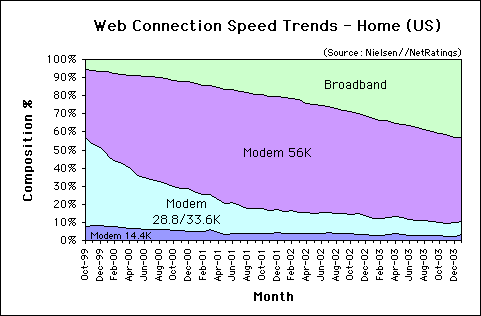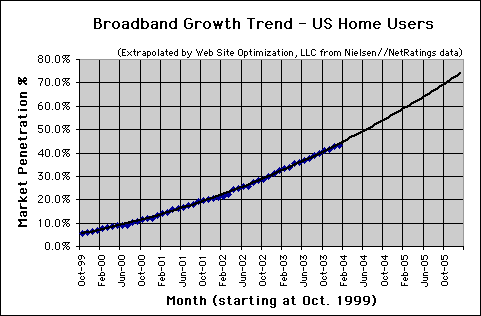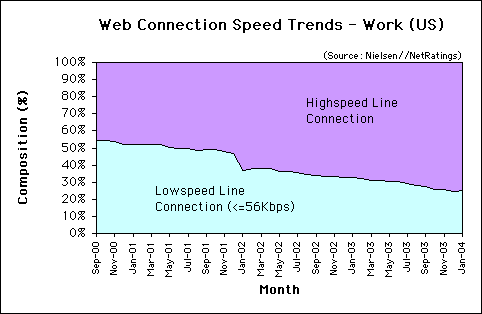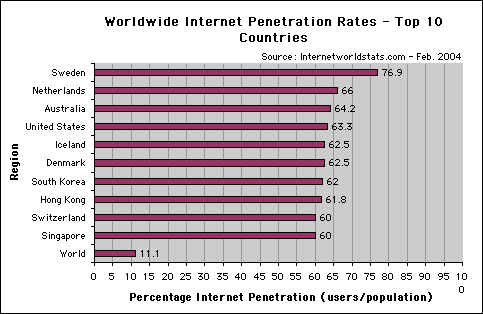Overall, broadband grew by 0.15 percentage points in January, with 43% of Internet-connected U.S. households enjoying a high-speed connection. 57% of US home users dial into the Internet with “narrowband” connections of 56Kbps or less. Sweden leads all countries in Internet penetration at 76.9%.
The charts below, derived from Nielsen//NetRatings and Internetworldstats.com, show trends in connection speeds to the Internet for users in the United States and worldwide.*
Home Connectivity in the US
As of January 2004, most users in the US connect to the Internet using dial-up modems of 56Kbps or less. 46.6% use 56Kbps modems, 7.2% use 28/33.3Kbps, and 3.2% use 14.4Kbps modems. In total, 57% of home users in the US connect to the Internet at 56Kbps or less (see Figure 1).
Web Connection Speed Trends – Home Users (US)
Figure 1: Web Connection Speed Trends – Home Users (US)
Source: Nielsen//NetRatings
Broadband Growth in the US
Broadband penetration in US homes increased by 0.15 percentage points in January. As of January 2004 broadband penetration was at 43%, up from 42.85% in December. This is lower than the average increase in broadband of 0.75 percentage points per month from October 1999 to December 2003. Extrapolating the data provided by Nielsen//NetRatings, we estimate that broadband share in the US should exceed 50% by June of 2004 (see Figure 2).
Broadband Connection Speed Trend – Home Users (US)
Figure 2: Broadband Connection Speed Trend – Home Users (US)
Extrapolated by Web Site Optimization, LLC from Nielsen//NetRatings data
Work Connectivity
Most workers in the US enjoy high-speed connections to the Internet. Most use a high-speed line such as a T1 connection, and share bandwidth between computers connected to an Ethernet network. The speed of each connection decreases as more employees hook up to the LAN. As of January of 2004, of those connected to the Internet, 75.1% of US users at work enjoy a high-speed connection, down 0.5 percentage points from 75.6% in December. 24.9% connect from work at 56Kbps or less (see Figure 3).
Web Connection Speed Trends – Work Users (US)
Figure 3: Web Connection Speed Trends – Work Users (US)
Source: Nielsen//NetRatings
Sweden Has Highest Internet Penetration Worldwide
Sweden leads all countries surveyed in overall Internet penetration, with 76.9% of the population on the Internet, according to Internetworldstats.com. The Netherlands follow with 66%, Australia next at 64.2%, the United States at 63.3%, and Iceland and Denmark tie at 62.5% Internet penetration.
Worldwide Internet Penetration Rates – Top Ten Countries
Figure 4: Worldwide Internet Penetration Rates – Top Ten Countries
Source: Internetworldstats.com
Further Reading
- Digital Access Index
- The ITU’s DAI shows that Sweden has the highest level of access to the Internet worldwide. The DAI includes the following factors: availability of infrastructure, affordability of access, educational level, quality of ICT services, and Internet usage. Note that this data is from 2002.
- Internet World Stats
- Tracks Internet usage worldwide using various trusted sources. Includes Internet penetration data on 240 countries and regions in the stats page. As of Dec. 2003 Sweden tops all countries in Internet penetration with 76.9%. By Enrique de Argaez.
*Note: “Users” signifies people connected to the Internet.
The Bandwidth Report is featured monthly on URLwire – news of useful and unique web content since 1994.




